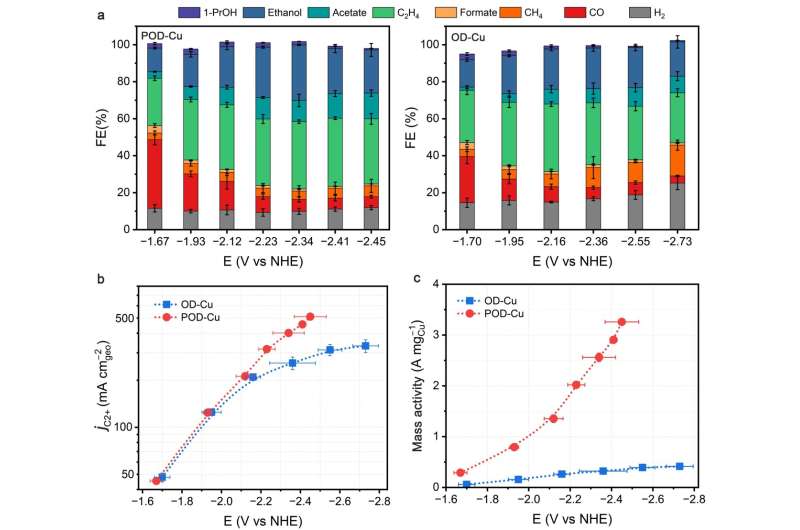This article has been reviewed according to Science X's editorial process and policies. Editors have highlighted the following attributes while ensuring the content's credibility:
fact-checked
trusted source
proofread
Efficient CO₂ electroreduction to multicarbon products on a defective Cu catalyst derived from La₂CuO₄ perovskite oxide

The electrochemical reduction of CO2 into value-added fuels and chemical feedstocks offers a sustainable route to store renewable electricity and to mitigate carbon emissions. Currently, Cu is the most promising material capable of catalyzing C-C coupling to yield more valuable multicarbon products.
However, a bulky flat Cu generally favors H2 and CH4 production, leading to unsatisfied C2+ selectivity. To surmount this challenge, many strategies have been exploited to improve catalytic performance of Cu, including morphology manipulation, surface modification, structural reconstruction, and so on.
Among these strategies, structural reconstruction is of particular interest because it is expected to introduce structural defects, which contain rich undercoordinated sites and thus are potential to catalyze CO2RR efficiently. However, designing advanced catalysts to achieve high-density defects via reconstruction and ultimately guide the reaction pathway remains challenging.
Recently, a research group led by Prof. Min-Rui Gao (Hefei National Laboratory for Physical Sciences at the Microscale, University of Science and Technology of China) showcases the great potential of perovskite materials for efficient production of valuable multicarbon compounds from CO2RR via structural reconstruction. The team employed La2CuO4 perovskite oxide as pre-catalyst and studied its structural evolution under CO2RR condition.
By multiple technique analyses, they found that CO2 can substantially promote the exsolution of La sites in La2CuO4 by forming complex with La oxides, leading to the collapse of perovskite structure with concomitant reduction and reorganization of Cu sites. The resultant polycrystalline Cu catalyst (POD-Cu) was composed of multiple nanocrystallites interconnected by abundant grain boundaries (GBs).
The researchers observed that these GBs can kinetically trap and stabilize lattice dislocations and deformations in polycrystalline materials, providing a way to create high-energy surfaces with abundant undercoordinated sites.
Using this GBs-rich POD-Cu catalyst, the researchers achieved a Faradaic efficiency of ~80.3% towards C2+ products with partial current densities over 400 mA cm-2 in neutral environment in a flow-cell electrolyzer, outperforming the conventional CuO-derived Cu (OD-Cu) counterparts.
By combining the structural and spectroscopic investigations, the team attributed the excellent catalytic activity of POD-Cu to abundant defective and undercoordinated sites, which are trapped and stabilized by the high-density GBs created from structural reconstruction.
The researchers suggested that these sites can bind the key COad intermediates stronger, which not only promoted the possibility of dimerization of neighboring COad species but also largely suppressed H2 evolution by limiting the access of Had intermediates to active sites.
This study showcases the promise of perovskite materials for efficient production of valuable multicarbon compounds via CO2RR electrochemistry. The researchers anticipate that these results may find immediate use in the design of next generation CO2RR catalysts base on flexible and efficient perovskite materials, which should aid the large-scale production of valuable multicarbon compounds by CO2 electrolysis.
The research is published in the journal National Science Open.
More information: Zhuang-Zhuang Niu et al, CO2-assisted formation of grain boundaries for efficient CO-CO coupling on a derived Cu catalyst, National Science Open (2022). DOI: 10.1360/nso/20220044
Provided by Science China Press



















